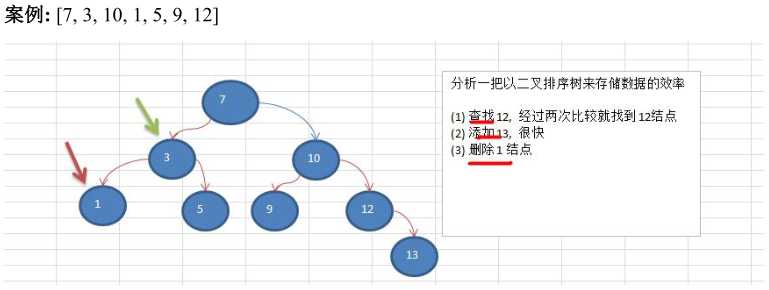JAVA数据结构与算法之二叉树(一)
2021-02-07 11:17
标签:意图 说明 方法 roo image 子节点 param string code 树存储方式的分析 代码示例: 节点实例: JAVA数据结构与算法之二叉树(一) 标签:意图 说明 方法 roo image 子节点 param string code 原文地址:https://www.cnblogs.com/pierceming/p/12776322.html二叉树
能提高数据 存储 , 读取的效率, 比如利用 二叉排序树(Binary Sort Tree),既可以保证数据的检索速度,同时也可以保证数据的 插入,删除,修改的速度。

树示意图:
二叉树遍历的说明1) 前序遍历: 先输出父节点,再遍历左子树和右子树
2) 中序遍历: 先遍历左子树,再输出父节点,再遍历右子树
3) 后序遍历: 先遍历左子树,再遍历右子树,最后输出父节点
4) 小结: 看输出父节点的顺序,就确定是前序,中序还是后序
package com.pierce.algorithm;
class BinaryTree {
private Node root;
public void setRoot(Node root) {
this.root = root;
}
//前序遍历
public void preOrder() {
if (this.root != null) {
this.root.preOrder();
} else {
System.out.println("二叉树为空,无法遍历");
}
}
//中序遍历
public void infixOrder() {
if (this.root != null) {
this.root.infixOrder();
} else {
System.out.println("二叉树为空,无法遍历");
}
}
//后序遍历
public void postOrder() {
if (this.root != null) {
this.root.postOrder();
} else {
System.out.println("二叉树为空,无法遍历");
}
}
//前序遍历
public Node preOrderSearch(int no) {
if (root != null) {
return root.preOrderSearch(no);
} else {
return null;
}
}
//中序遍历
public Node infixOrderSearch(int no) {
if (root != null) {
return root.infixOrderSearch(no);
} else {
return null;
}
}
//后序遍历
public Node postOrderSearch(int no) {
if (root != null) {
return this.root.postOrderSearch(no);
} else {
return null;
}
}
//删除结点
public void delNode(int no) {
if(root != null) {
//如果只有一个 root 结点, 这里立即判断 root 是不是就是要删除结点
if(root.getNo() == no) {
root = null;
} else {
//递归删除
root.delNode(no);
}
}else{
System.out.println("空树,不能删除~");
}
}
}
package com.pierce.algorithm;
/**
* 〈一句话功能简述〉
* 〈〉
*
* @author Administrator
* @create 2020/4/25
* @since 1.0.0
*/
//先创建 HeroNode 结点
class Node {
private int no;
private String name;
private Node left; //默认 null
private Node right; //默认 null
public Node(int no, String name) {
this.no = no;
this.name = name;
}
public int getNo() {
return no;
}
public void setNo(int no) {
this.no = no;
}
public String getName() {
return name;
}
public void setName(String name) {
this.name = name;
}
public Node getLeft() {
return left;
}
public void setLeft(Node left) {
this.left = left;
}
public Node getRight() {
return right;
}
public void setRight(Node right) {
this.right = right;
}
@Override
public String toString() {
return "HeroNode [no=" + no + ", name=" + name + "]";
}
//编写前序遍历的方法
public void preOrder() {
System.out.println(this); //先输出父结点
//递归向左子树前序遍历
if (this.left != null) {
this.left.preOrder();
}
//递归向右子树前序遍历
if (this.right != null) {
this.right.preOrder();
}
}
//中序遍历
public void infixOrder() {
//递归向左子树中序遍历
if (this.left != null) {
this.left.infixOrder();
}
//输出父结点
System.out.println(this);
//递归向右子树中序遍历
if (this.right != null) {
this.right.infixOrder();
}
}
//后序遍历
public void postOrder() {
if (this.left != null) {
this.left.postOrder();
}
if (this.right != null) {
this.right.postOrder();
}
System.out.println(this);
}
// 前序遍历查找
/**
*
* @param no 查找 no
* @return 如果找到就返回该 Node ,回 如果没有找到返回 null
*/
public Node preOrderSearch(int no) {
System.out.println(" 进入前序遍历");
// 比较当前结点是不是
if(this.no == no) {
return this;
}
//1. 则判断当前结点的左子节点是否为空,如果不为空,则递归前序查找
//2. 如果左递归前序查找,找到结点,则返回
Node resNode = null;
if(this.left != null) {
resNode = this.left.preOrderSearch(no);
}
if(resNode != null) {// 说明我们左子树找到
return resNode;
}
//1. 左递归前序查找,找到结点,则返回,否继续判断,
//2. 当前的结点的右子节点是否为空,如果不空,则继续向右递归前序查找
if(this.right != null) {
resNode = this.right.preOrderSearch(no);
}
return resNode;
}
// 中序遍历查找
public Node infixOrderSearch(int no) {
// 判断当前结点的左子节点是否为空,如果不为空,则递归中序查找
Node resNode = null;
if(this.left != null) {
resNode = this.left.infixOrderSearch(no);
}
if(resNode != null) {
return resNode;
}
System.out.println(" 进入中序查找");
// 如果找到,则返回,如果没有找到,就和当前结点比较,如果是则返回当前结点
if(this.no == no) {
return this;
}
// 否则继续进行右递归的中序查找
if(this.right != null) {
resNode = this.right.infixOrderSearch(no);
}
return resNode;
}
// 后序遍历查找
public Node postOrderSearch(int no) {
// 判断当前结点的左子节点是否为空,如果不为空,则递归后序查找
Node resNode = null;
if(this.left != null) {
resNode = this.left.postOrderSearch(no);
}
if(resNode != null) {// 说明在左子树找到
return resNode;
}
// 如果左子树没有找到,则向右子树递归进行后序遍历查找
if(this.right != null) {
resNode = this.right.postOrderSearch(no);
}
if(resNode != null) {
return resNode;
}
System.out.println(" 进入后序查找");
// 如果左右子树都没有找到,就比较当前结点是不是
if(this.no == no) {
return this;
}
return resNode;
}
//递归删除结点
//1.如果删除的节点是叶子节点,则删除该节点
//2.如果删除的节点是非叶子节点,则删除该子树
public void delNode(int no) {
//思路
/*
* 1. 因为我们的二叉树是单向的,所以我们是判断当前结点的子结点是否需要删除结点,而不能去判断
当前这个结点是不是需要删除结点.
2. 如果当前结点的左子结点不为空,并且左子结点 就是要删除结点,就将 this.left = null; 并且就返回
(结束递归删除)
3. 如果当前结点的右子结点不为空,并且右子结点 就是要删除结点,就将 this.right= null ;并且就返回
(结束递归删除)
4. 如果第 2 和第 3 步没有删除结点,那么我们就需要向左子树进行递归删除
5. 如果第 4 步也没有删除结点,则应当向右子树进行递归删除.
*/
//2. 如果当前结点的左子结点不为空,并且左子结点 就是要删除结点,就将 this.left = null; 并且就返回(结束递归删除)
if(this.left != null && this.left.no == no) {
this.left = null;
return;
}
//3.如果当前结点的右子结点不为空,并且右子结点 就是要删除结点,就将 this.right= null ;并且就返回(结束递归删除)
if(this.right != null && this.right.no == no) {
this.right = null;
return;
}
//4.我们就需要向左子树进行递归删除
if(this.left != null) {
this.left.delNode(no);
}
//5.则应当向右子树进行递归删除
if(this.right != null) {
this.right.delNode(no);
}
}
}
下一篇:Java专题十二:网络
文章标题:JAVA数据结构与算法之二叉树(一)
文章链接:http://soscw.com/index.php/essay/52159.html